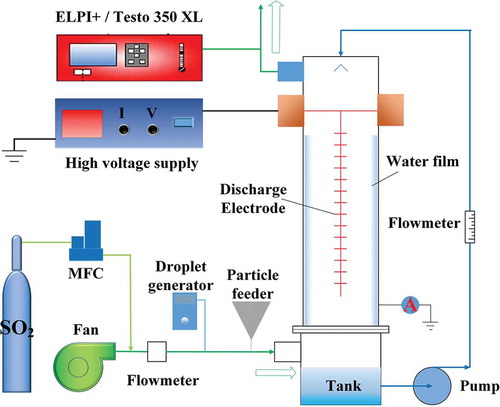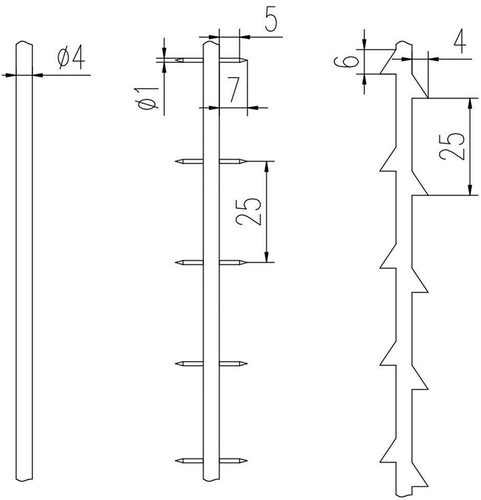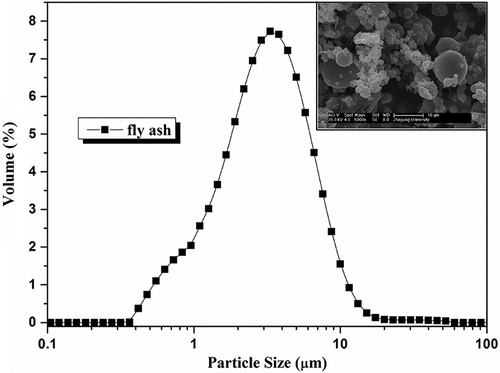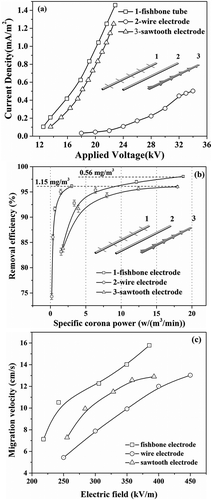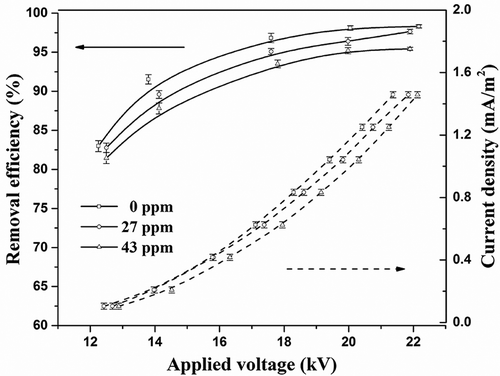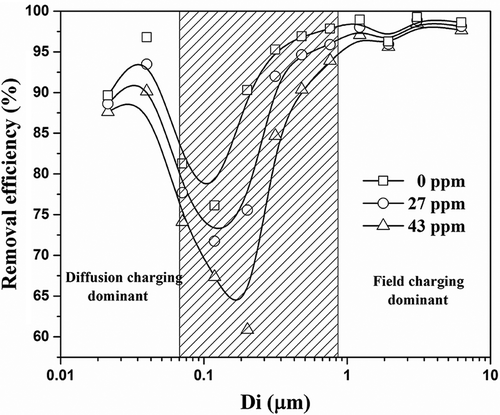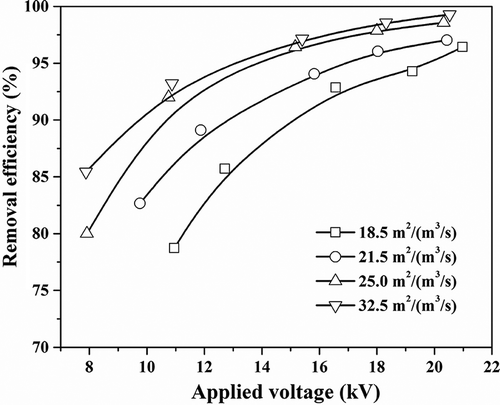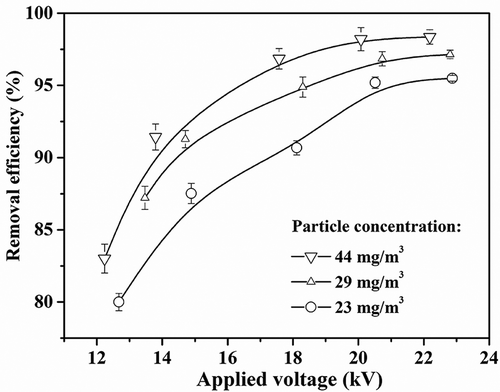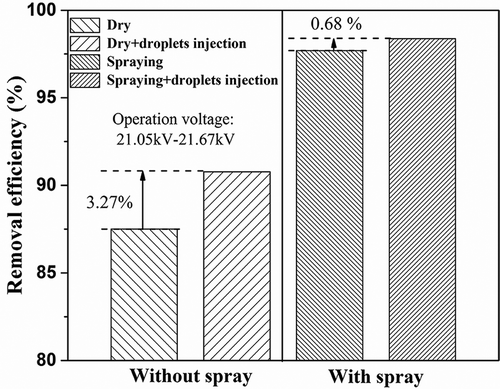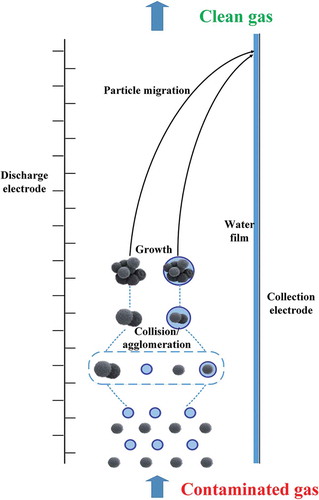ABSTRACT
Electrostatic precipitation is considered as an effective technology for fine particle removal. A lab-scale wet electrostatic precipitator (ESP) with wire-to-plate configuration was developed to study particle migration and collection. The performance of the wet ESP was evaluated in terms of the corona discharge characteristics, total removal efficiency and fractional removal efficiency. The corona discharge characteristics and particle removal abilities of the wet ESP were investigated and compared with dry ESP. Particle removal efficiency was influenced by discharge electrode type, SO2 concentration, specific collection area (SCA) and particle/droplet interaction. Results showed that the particle removal efficiency of wet ESP was elevated to 97.86% from 93.75% of dry ESP. Three types of discharge electrodes were investigated. Higher particle removal efficiency and larger migration velocity could be obtained with fishbone electrode. Particle removal efficiency decreased by 2.87% when SO2 concentration increased from 0 ppm to 43 ppm as a result of the suppression of corona discharge and particle charging. The removal efficiency increased with higher SCA, but it changed by only 0.71% with the SCA increasing from 25.0 m2/(m3/s) to 32.5 m2/(m3/s). Meanwhile, the increasing of particle and droplet concentration was favorable to the particle aggregation and improved particle removal efficiency.
Implications: This work tends to study the particle migration and collection under spraying condition. The performance of a wet electrostatic precipitator (ESP) is evaluated in terms of the corona discharge characteristics, total particle removal efficiency, and fractional particle removal efficiency. The effects of water droplets on particle removal, especially on removal of particles with different sizes, is investigated. The optimization work was done to determine appropriate water consumption, discharge electrode type, and specific collection area, which can provide a basis for wet ESP design and application.
Introduction
Particulate matter (PM) pollution is one of the major health and environmental concerns, which has aroused increasing social awareness due to its hazardous effects on human health in the past years, especially to children and the elderly (Pope et al., Citation2002; Biswas and Wu, Citation2005). Fine particles are more harmful than large particles because of their toxic chemical and physical characteristics. More importantly, they can reach the deepest regions of the lungs, damaging the respiratory system and even the cardiovascular system when inhaled (Jaworek et al., Citation2007; Tammaro et al., Citation2012; Thonglek and Kiatsiriroat, Citation2014). Therefore, PM control from the original sources comes to be an effective method for good air quality free from PM pollution.
Table 1. Chemical composition of the fly ash (% by weight).
Electrostatic precipitator (ESP) is widely employed for particle removal from flue gas in various industrial processes, including boilers, incinerators, coal-fired power plants, mining installations, metallurgical and chemical industries, etc. ESP is characterized as durable, cost-effective, and easy to operate compared with inertial separation, wet scrubber, and fabric filter. However, conventional dry ESP still encounters some problems that restrict the performance of ESP. For example, high-resistivity dust may cause back-corona discharge due to charge accumulation in the dust layer on the collection electrodes. Dust reentrainment will occur when the dust is of low resistivity (Mizuno, Citation2000; Jaworek et al., Citation2007; Parker, Citation2012).
Wet ESP is ideal to deal with wider varieties of PM pollutants, especially for particles that are sticky and corrosive and those with extremely low or high resistivity. Back-corona discharge and dust reentrainment can be totally avoided because dusts collected on the plates are removed continuously by water film (Mizuno, Citation2000). Numerous studies have been done on the performance of wet ESP, including the investigations of geometric parameters, electrode material, and material surface treatments (Kim et al., Citation2010; Chang et al., Citation2011; Jeong et al., Citation2013; Najafabadi et al., Citation2014). Some researchers investigated the effects of water on particle removal in laboratory-scale wet ESP. Removal efficiency of both submicron particles and large particles can be improved significantly by water film (Wang and You, Citation2013). The efficiency of wet ESPs could also be improved with the assistance of particle condensation growth by water vapor (Qi and Zhang, Citation2013; Wang and You, Citation2013; Chen et al., Citation2014). In practical applications, wet ESPs with spraying are more widely used, and there always exist entrained droplets or condensed droplets in the flue gas. However, the role of water droplets on particle removal is still unknown, especially on particle removal with different sizes.
In this study, a vertical wet ESP with wire-to-plate configuration was developed to study particle migration and collection under spraying condition. An optimization work was done in terms of water consumption, specific collection area, and discharge electrode types for this wet ESP. The corona discharge characteristics and particle charging were analyzed to investigate the effects of sulfur dioxide (SO2) on particle removal. The performance of particle removal with different particle and droplet concentrations was also investigated. Conclusions obtained can provide a basis for wet ESP design and application.
Experimental setup and methods
Experimental setup
A schematic of the experimental system is shown in . The experimental system mainly consisted of a simulated gas generation system, a wet ESP system, and a measurement system. The gas entering the wet ESP was a mixture of air, particles, SO2, and water droplets, which simulated the gas condition after wet flue gas desulfurization (WFGD). Particles were added into the gas flow by a vibrator feeder 1200 mm long upstream of the inlet of the wet ESP to get good distribution. The flow rate of SO2 was controlled by a mass flow meter (Seven Star Huachuang Co., Ltd., Beijing, China) with an accuracy of ±0.1 mL/min. Water droplets were injected at the upstream of the wet ESP to simulate the humidified gas condition, which were generated by an ultrasonic nebulizer.
The contaminated gas passed through the wet ESP upwards in a single channel with wire-to-plate configuration. Three types of discharge electrodes were used in our study, and the detailed geometries are shown in . The discharge electrode was made of stainless steel, which was energized with a negative DC (direct current) voltage controlled within a range of 0–24.00 kV by a high-frequency (20 kHz) power supply (TRC2020; Telsman, Dalian, China). The voltage was measured using a high-voltage voltmeter (CC1940-3; maximum AC/DC [alternating/direct current] = 30 kV; precision: ±300 V). The discharge current was measured by an ammeter (range: 0–1000 μA; precision: ±10 μA). The collection electrodes (1040 mm long and 240 mm wide) were two grounded steel plates. The distance between the discharge electrode and the collection electrode was 60 mm. The gas flow rate within the wet ESP was typically 120 m3/hr, and the corresponding velocity was 1.16 m/sec except for the investigation of particle removal of different specific collection areas (SCAs). A solid cone nozzle was used for forming water film on the collection plates. To make uniform water film on the collection plates, the plates were treated with acid pickling and coating. The water droplets sprayed from the center of the two plates, and the water film spread with an angel of 60°. The water film was formed after the water droplet collided with the plates.
PM and SO2 concentrations were continuously measured by ELPI+ (electrical low pressure impactor; Dekati Ltd., Kangasala, Finland) and Testo 350XL (Testo Instrumental Trading, Co., Ltd., Shanghai, China) at the outlet of the wet ESP, respectively. ELPI+ is widely used as an on-line method for measuring concentration and size distribution of dust particle, diesel particulate matter, and sulfuric acid aerosol in previous study. Its setup and the measurement principle have been introduced in several reports, and the accuracy has also been proved (Brachert et al., Citation2014; Mertens et al., Citation2014; Anderlohr et al., Citation2015; Wang et al., Citation2016). In this study, the initial concentration of PM referred to the concentration with power supply off, which excluded the wall effects. The performance of the wet ESP could be expressed in terms of particle removal efficiency (ƞ), which can be obtained by the following equation:
where is the initial PM concentration (1/cm3) and
is the PM concentration (1/cm3) after purification.
Sampling methods
Isokinetic sampling is generally utilized for particle sampling to reduce sampling error. When the gas velocity equals the sampling velocity, particles in the gas can be sampled in consistent with the actual state. The isokinetic sampling is realized by using sampling nozzles with different inner diameters. The diameter of the sampling nozzle can be determined by the following equation:
where is the diameter of sampling nozzle,
is the sampling rate of ELPI+, and
is the gas velocity.
Besides, particle sampling is more complicated for wet flue gas because the entrained droplets and condensed droplets can be mistaken as particles by ELPI+. To keep the results free from the disturbance of water droplets, the gas was heated in a sampling tube before entering into the diluter (Dekati diluter). The diluter was a two-stage configuration where the first diluter was heated and the second one operated at ambient temperature. Although unwanted condensation and nucleation could be eliminated, gas heating and diluting still have an effect on particle size distribution (Abdul-Khalek et al., Citation1999).
Particle characteristics
Fly ash collected from a coal-fired power plant (1000 MW; Jiaxing, Zhejiang Province, China) was utilized as test particle, of which the chemical composition and size distribution are presented in and , respectively. The chemical composition was analyzed according to the standard testing method for the analysis of coal ash in China (GB/T 1574-2007) (Standardization Administration of the People’s Republic of China, Citation2008). The main compositions were SiO2, Al2O3, and Fe2O3. The size distribution of the particle was measured by a laser particle size analyzer (LS-230; Coulter, Brea, California, USA). Detailed methods had been described in the previous work (Xu et al., Citation2015). The median particle diameter was 3.25 μm, and the mean particle diameter was 4.00 μm. The volume ratio of PM2.5 was 41.36%, that of PM2.5–10 (particles with an aerodynamic diameter between 2.5 and 10 μm) was 54.05%, and that of PM10 (particles with an aerodynamic diameter larger than 10 μm) was 2.31%. These fine particles could meet the requirements of these experiments.
Results and discussion
Comparison between wet ESP and dry ESP
Current-voltage (I-V) characteristics and corona onset voltage (COV) for wet ESP and dry ESP are shown in and , respectively. Difference between the two cases was that the dry one operated without spraying. The results showed that the spray water led to an increase of current density, and the COV tended to turn lower when the water flow rate increased. The COV was 12.10 kV under dry condition, whereas it decreased to 11.02 kV when the water flow rate was 120 L/hr. Two reasons were proposed to account for this phenomenon. First, the water film led to space decrease between discharge electrode and collection plates. Second, the droplets generated by spraying would distort the original electric field distribution and rebuild a stronger electric field around it (Tardiveau and Marode, Citation2003). The migration and diffusion of electrons could be accelerated due to the stronger local electric field; thus, the corona discharge started under lower voltage and larger current density was achieved.
Fractional removal efficiency and total removal efficiency for wet ESP and dry ESP are shown in and , respectively. The initial particle concentration was 33 mg/m3 and the applied voltage was 33 kV. Total particle removal efficiency of wet ESP was improved from 93.75% to 97.86% at water flow rate of 60 L/hr compared with dry ESP. In particular, large particles obtained a very high removal efficiency with the effects of both electrostatic and spraying under this condition. Thus, when the water flow rate increased to 120 L/hr, the removal efficiency of large particles increased slightly. For small particles, they were easier to coagulate by water droplets when the water flow rate increased; thus, the removal efficiency increased more significantly than large ones.
Figure 5. (a) Fractional removal efficiency and (b) total particle removal efficiency at different water flow rates.
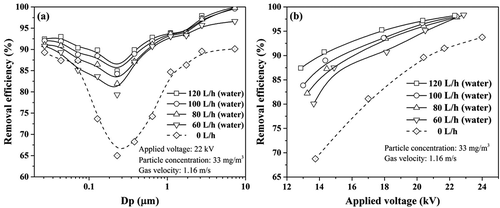
indicated that when the applied voltage exceeded 22.00 kV, the total removal efficiency varied by only 0.51% with the water flow rate increasing from 60 to 120 L/hr. Therefore, it was not necessary to increase the water consumption to improve the particle removal efficiency when the flow rate exceeded a certain value.
Optimization of discharge electrode geometry for wet ESP
The performance of particle removal and migration with three types of discharge electrodes was investigated. The I-V curves are shown in , and the fishbone electrode could generate more corona current under the same applied voltage. Specific corona power is a function of corona current and applied voltage, which indicates the energy consumption of an ESP. As can be seen from , the particle removal efficiency increased with the increasing of specific corona power for all the three types of electrodes. The wire electrode operated at lower specific corona power than sawtooth and fishbone electrodes. Particle removal efficiency of wire electrode increased from 74.31% to 96.15% when the specific corona power increased from 0.18 to 3.00 W/(m3/min). The sawtooth and fishbone electrodes worked at the same specific corona power range and the fishbone type could obtain higher particle removal efficiency, which could be as high as 98.06% at the largest specific corona power when the particle concentration was 29 mg/m3. shows that higher migration velocity could be achieved by fishbone electrode compared with the other two types. The migration velocities for the three types of electrodes were 15.78, 12.89, and 12.00 cm/sec under the electric field around 400 kV/m, respectively. Nonuniform geometry of the electrode could lead to stronger local electric field, which quickly accelerated the charged particles. At the same specific corona power, although the charge number was almost the same, the local electric field of fishbone electrode could provide higher particle removal efficiency. It should be noted that the migration velocity here was obtained from the Deutsch equation (Mizuno, Citation2000), which differs from the theoretical migration velocity in eq 9. Since the fishbone electrode stood out among the three types for particle removal, it was chosen for the following tests.
Particle removal in wet ESP under different conditions
Effects of SO2 concentration
displays the corona discharge characteristics and particle removal efficiency in the presence of SO2. The current density decreased by 13.51%, and the particle removal efficiency decreased by 2.87% at voltage around 21.00 kV when the SO2 concentration increased from 0 to 43 ppm. The variation resulted from strong electronegativity of SO2 molecule. The electronegativity could be characterized by collision number of electron attachment, and the values for O2 and N2 were 8.7 × 108 times and ∞ times, respectively, whereas it was only 3.5 × 103 times for SO2 (Tang, Citation2010). This indicated that it was easier for a SO2 molecule to integrate with an electron. Negative ion SO2− formed when a SO2 molecule integrated with an electron, which could be expressed as . Namely, electronegative SO2 gas decreased the ionization rates between electrons and gas molecules. Accordingly, the corona current was suppressed in the presence of SO2 compared with pure air.
also indicated that the decreasing of particle removal efficiency was coincident with that of current density under different SO2 concentration conditions. The correlation between particle removal efficiency and current density can be analyzed by particle charging theory as follows.
For a spherical particle, the charging mechanism can be classified as field charging and diffusion charging (Mizuno, Citation2000). Field charging of a spherical particle is given by
where is the saturation charge (C),
is the charging time (sec),
is the time constant of the field charging (sec),
is the permittivity of vacuum,
is the specific permittivity,
is the particle diameter (m),
is the field strength (V/m), and
is the current density (A/m2).
Diffusion charging of a spherical particle is given by
where is a charge constant (C),
is the time constant of diffusion charging (sec),
is the Boltzmann constant,
is the temperature (K),
is the electronic charge, Ci is the thermal velocity of ion (m/sec) and ni is the number density of ions in space (Vm/sec2).
According to the charging theory above, field charging is related to current density (J), and the reduction of current density will result in a decreasing of particle charging. Diffusion charging also decreases with the decreasing of number density of ions in space. When the particle concentration is constant, the reduction of corona current in the presence of SO2 will cause insufficient particle charging. The theoretical migration velocity of particle in electric field can be calculated by eq 9. As can be seen, the migration velocity is proportional to the charge of particle (q). Therefore, the decreasing of particle removal efficiency is probably due to this mechanism caused by electronegative SO2 gas.
where ω is the migration velocity (m/sec), q is the particle charge (C), μ is the viscosity (Pa·sec) and Cm is the Cunningham correction factor.
The results in illustrated that the particle removal efficiency decreased obviously in the size range of 0.1~1 μm. Both field and diffusion charging are inadequate in this size range (Parker, Citation2012). Besides, some researchers pointed out that the residual SO2 in the flue gas could be oxidized to form sulfuric acid aerosols by corona discharge (Anderlohr et al., Citation2015), which could also reduce the particle removal efficiency.
Effects of specific collection area
displays the particle removal efficiency of different SCAs. The results indicated that the particle removal efficiency increased significantly with the increase of SCA. Larger SCA meant longer residence time for particles in an electric field. According to the charging theory mentioned above, both field charging and diffusion charging increased with the increasing of charging time. Nevertheless, particle charging would nearly reach saturation charging when the charging time exceeded 1 sec (Long and Yao, Citation2010). After saturation charging, the particle charge amount and particle removal efficiency increased little with the increasing of residence time. When SCA increased from 25.0 to 32.5 m2/(m3/sec), the particle removal efficiency increased by only 0.71% at voltage around 21.00 kV. In practical application, residence/charging time should be taken into consideration to determine appropriate SCA when designing an ESP.
Effects of particle-droplet interaction
shows the particle removal efficiency at different particle concentrations. Mass concentration rather than number concentration was used in these experiments. The conversion from number concentration to mass concentration can be done by the program of ELPI+ with several assumptions (Zhang et al., Citation2013). The particle removal efficiency increased with the increasing of particle concentration. This could be attributed to that more collision and agglomeration occurred between charged particles with the increasing particle concentration.
Water droplets were injected at the upstream of the wet ESP to adjust the humidity of the flue gas. The enhancement by water droplets on particle removal is shown in . Both wet condition and dry condition were investigated within the operation voltage of 21.05–21.67 kV, and the particle removal efficiency was enhanced with water droplets by 3.27% and 0.68%, respectively. The spraying effects led to the enhancement by water droplet injection being not significant.
Water droplets have similar characteristics to particles, and they both go through the processes of charging, migrating, and capturing in a wet ESP. However, the particle removal efficiency increased in the presence of water droplets instead of decreasing. This can be attributed to that water droplets were injected into the flue gas before the wet ESP. The Reynolds number could be as high as 5.98 × 104 when the gas velocity in the pipe was 14 m/sec. The gas was in a fully developed turbulent flow state, which meant that particles and droplets had high possibilities to collide with each other. The percentage of small particles decreased evidently whereas the percentage of large particles increased in the presence of water vapor content (Qi and Zhang, Citation2013). Particles became larger by collision and agglomeration with droplets. Larger particles were easier to be collected, and thus the particle removal efficiency would increase (as schematized in ).
Conclusion
In this study, a vertical wet ESP with wire-to-plate configuration was constructed and developed to study particle migration and removal under spraying conditions. The performance of the wet ESP was evaluated in terms of the corona discharge characteristics, total removal efficiency, and fractional removal efficiency.
The spraying water played a significant role in the operation of wet ESP, which led to a lower COV and higher current density. Compared with dry ESP, the particle removal efficiency of wet ESP was improved from 93.75% to 97.86%, but when the water flow rate increased from 60 to 120 L/hr, the removal efficiency of total particle varied only 0.51%. Therefore, it is unnecessary to improve the particle removal efficiency by increasing the water consumption. An optimization work was done on three types of electrodes under different specific corona power ranges. Higher migration velocity and particle removal efficiency could be obtained with fishbone electrode, indicating that nonuniform geometry of fishbone electrode was more beneficial and reliable for particle removal. The corona discharge and particle removal could also be influenced by the residual SO2 in the flue gas. With the SO2 concentration increasing from 0 to 43 ppm, the current density decreased by 13.5% and the particle removal efficiency decreased by 2.87% at voltage around 21.00 kV, respectively. Meanwhile, the particle removal efficiency increased with higher SCA, but it changed by only 0.71% with the SCA increasing from 25.0 to 32.5 m2/(m3/sec).
Funding
This work was supported by National Program on Key Basic Research Project (973 Program) (No. 2013CB228504), National High-tech R&D Program of China (863 Program) (No. 2013AA065002), Hangzhou Key Research & Development Innovation Project (No. 20142011A28), Science and Technology Development Project of Shandong Province (No.2014GJJS0501), and Young Talent Cultivation Project of Zhejiang Association for Science and Technology (No. 2016YCGC015)
Additional information
Funding
Notes on contributors
Zhengda Yang
Zhengda Yang is a doctoral degree candidate, Chenghang Zheng is an associate professor, Qianyun Chang is a doctoral degree candidate, Yi Wan has received a master’s degree, Yi Wang is an engineer, Xiang Gao is a professor, and Kefa Cen is a professor at the State Key Laboratory of Clean Energy Utilization, Zhejiang University, Hangzhou, China.
Chenghang Zheng
Zhengda Yang is a doctoral degree candidate, Chenghang Zheng is an associate professor, Qianyun Chang is a doctoral degree candidate, Yi Wan has received a master’s degree, Yi Wang is an engineer, Xiang Gao is a professor, and Kefa Cen is a professor at the State Key Laboratory of Clean Energy Utilization, Zhejiang University, Hangzhou, China.
Qianyun Chang
Zhengda Yang is a doctoral degree candidate, Chenghang Zheng is an associate professor, Qianyun Chang is a doctoral degree candidate, Yi Wan has received a master’s degree, Yi Wang is an engineer, Xiang Gao is a professor, and Kefa Cen is a professor at the State Key Laboratory of Clean Energy Utilization, Zhejiang University, Hangzhou, China.
Yi Wan
Zhengda Yang is a doctoral degree candidate, Chenghang Zheng is an associate professor, Qianyun Chang is a doctoral degree candidate, Yi Wan has received a master’s degree, Yi Wang is an engineer, Xiang Gao is a professor, and Kefa Cen is a professor at the State Key Laboratory of Clean Energy Utilization, Zhejiang University, Hangzhou, China.
Yi Wang
Zhengda Yang is a doctoral degree candidate, Chenghang Zheng is an associate professor, Qianyun Chang is a doctoral degree candidate, Yi Wan has received a master’s degree, Yi Wang is an engineer, Xiang Gao is a professor, and Kefa Cen is a professor at the State Key Laboratory of Clean Energy Utilization, Zhejiang University, Hangzhou, China.
Xiang Gao
Zhengda Yang is a doctoral degree candidate, Chenghang Zheng is an associate professor, Qianyun Chang is a doctoral degree candidate, Yi Wan has received a master’s degree, Yi Wang is an engineer, Xiang Gao is a professor, and Kefa Cen is a professor at the State Key Laboratory of Clean Energy Utilization, Zhejiang University, Hangzhou, China.
Kefa Cen
Zhengda Yang is a doctoral degree candidate, Chenghang Zheng is an associate professor, Qianyun Chang is a doctoral degree candidate, Yi Wan has received a master’s degree, Yi Wang is an engineer, Xiang Gao is a professor, and Kefa Cen is a professor at the State Key Laboratory of Clean Energy Utilization, Zhejiang University, Hangzhou, China.
References
- Abdul-Khalek, I., D. Kittelson, and F. Brear. 1999. The Influence of Dilution Conditions on Diesel Exhaust Particle Size Distribution Measurements. SAE Technical Paper. doi:10.4271/1999-01-1142
- Anderlohr, C., L. Brachert, J. Mertens, and K. Schaber. 2015. Collection and generation of sulfuric acid aerosols in a wet electrostatic precipitator. Aerosol Sci. Technol. 49:144–151. doi:10.1080/02786826.2015.1008624
- Biswas, P., and C.Y. Wu. 2005. Nanoparticles and the environment. J. Air Waste Manage. Assoc. 55:708–746. doi:10.1080/10473289.2005.10464656
- Brachert, L., J. Mertens, P. Khakharia, and K. Schaber. 2014. The challenge of measuring sulfuric acid aerosols: Number concentration and size evaluation using a condensation particle counter (CPC) and an electrical low pressure impactor (ElPI+). J. Aerosol Sci. 67:21–27. doi:10.1016/j.jaerosci.2013.09.006
- Chang, J.C., Y. Dong, Z.Q. Wang, P. Wang, P. Chen, and C.Y. Ma. 2011. Removal of sulfuric acid aerosol in a wet electrostatic precipitator with single terylene or polypropylene collection electrodes. J. Aerosol Sci. 42:544–554. doi:10.1016/j.jaerosci.2011.05.006
- Chen, T.-M., C.-J. Tsai, S.-Y. Yan, and S.-N. Li. 2014. An efficient wet electrostatic precipitator for removing nanoparticles, submicron and micron-sized particles. Sep. Purif. Technol. 136:27–35. doi:10.1016/j.seppur.2014.08.032
- Jaworek, A., A. Krupa, and T. Czech. 2007. Modern electrostatic devices and methods for exhaust gas cleaning: A brief review. J. Electrost, 65:133–155. doi:10.1016/j.elstat.2006.07.012
- Jeong, S.H., D.K. Shim, W.S. Hong, J.H. Hong, and S.-S. Lee. 2013. Performance of a pilot-scale wet electrostatic precipitator for the control of sulfuric acid mist and fine particulates. Pol. J. Environ. Stud. 22:409–415.
- Kim, H.-J., B. Han, Y.-J. Kim, and S.-J. Yoa. 2010. Characteristics of an electrostatic precipitator for submicron particles using non-metallic electrodes and collection plates. J. Aerosol Sci. 41:987–997. doi:10.1016/j.jaerosci.2010.08.001
- Long, Z.W., and Q.A. Yao. 2010. Evaluation of various particle charging models for simulating particle dynamics in electrostatic precipitators. J. Aerosol Sci. 41:702–718. doi:10.1016/j.jaerosci.2010.04.005
- Mertens, J., L. Brachert, D. Desagher, M.L. Thielens, P. Khakharia, E. Goetheer, and K. Schaber. 2014. ElPI+ measurements of aerosol growth in an amine absorption column. Int. J. Greenhouse Gas Control 23:44–50. doi:10.1016/j.ijggc.2014.02.002
- Mizuno, A. 2000. Electrostatic precipitation. IEEE Trans. Dielectr. Electr. Insul. 7:615–624. doi:10.1109/94.879357
- Najafabadi, M.M., H.B. Tabrizi, A. Aramesh, and M.A. Ehteram. 2014. Effects of geometric parameters and electric indexes on performance of a vertical wet electrostatic precipitator. J. Electrost. 72:402–411. doi:10.1016/j.elstat.2014.06.005
- Parker, K.R. 2012. Applied Electrostatic Precipitation. New York: Springer Science & Business Media.
- Pope, C.A., R.T. Burnett, M.J. Thun, E.E. Calle, D. Krewski, K. Ito, and G.D. Thurston. 2002. Lung cancer, cardiopulmonary mortality, and long-term exposure to fine particulate air pollution. JAMA 287:1132–1141. doi:10.1001/jama.287.9.1132
- Qi, L.Q., and Y.J. Zhang. 2013. Effects of water vapor on flue gas conditioning in the electric fields with corona discharge. J. Hazard. Mater. 256–257:10–15.
- Standardization Administration of the People’s Republic of China. 2008. Test method for analysis of coal ash. Beijing: Standards Press of China.
- Tammaro, M., F. Di Natale, A. Salluzzo, and A. Lancia. 2012. Heterogeneous condensation of submicron particles in a growth tube. Chem. Eng. Sci. 74:124–134. doi:10.1016/j.ces.2012.02.023
- Tang, M.K. 2010. The Electrical Characteristic of Dust Particles in High-Voltage Electrostatic Field. Beijing: Chemical Industry Press.
- Tardiveau, P., and E. Marode. 2003. Point-to-plane discharge dynamics in the presence of dielectric droplets. J. Phys. D Appl. Phys. 36:1204–1211. doi:10.1088/0022-3727/36/10/309
- Thonglek, V., and T. Kiatsiriroat. 2014. Agglomeration of sub-micron particles by a non-thermal plasma electrostatic precipitator. J. Electrost. 72:33–38. doi:10.1016/j.elstat.2013.11.006
- Wang, X., J. Chang, C. Xu, J. Zhang, P. Wang, and C. Ma. 2016. Collection and charging characteristics of particles in an electrostatic precipitator with a wet membrane collecting electrode. J. Electrost. 83:28–34. doi:10.1016/j.elstat.2016.07.007
- Wang, X., and C. You. 2013. Effects of thermophoresis, vapor, and water film on particle removal of electrostatic precipitator. J. Aerosol Sci. 63:1–9. doi:10.1016/j.jaerosci.2013.04.003
- Xu, X., X. Gao, P. Yan, W. Zhu, C. Zheng, Y. Wang, Z. Luo, and K. Cen. 2015. Particle migration and collection in a high-temperature electrostatic precipitator. Sep. Purif. Technol. 143:184–191. doi:10.1016/j.seppur.2015.01.016
- Zhang, X.M., F.D. Feng, S.R. Li, X.J. Tang, Y.F. Huang, Z. Liu, and K.P. Yan. 2013. Aerosol formation from styrene removal with an AC/DC streamer corona plasma system in air. Chem. Eng. J. 232:527–533. doi:10.1016/j.cej.2013.08.009

